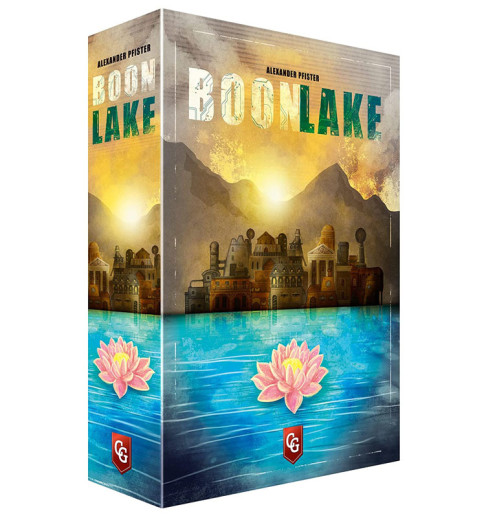Please
come to Boon Lake and stay for a while.
There are opportunities to explore, breed cattle, develop land, and build
to improve the lives of others in the community. Through the region, a river rich with
resources meanders and surrounds a variety of different terrains. What adventures and new experiences will you have? There are so many possibilities!
Boon
Lake is an action-selection, card-driven, tile laying, area control and resource
management game in which players compete to earn the most points over two
rounds of play that are punctuated with four interim scoring breaks that take
place half-way through and at the end of each round. Players have boats that move down the river
when they complete each turn. Once a
player passes one of the four river locks, game play stops for an interim
scoring break. Then the next sub-round
begins with the next player in turn order.
After the completion of the fourth interim scoring, game end scoring begins
and the person with the most points wins.
The
Action Board:
The
first decision of a player’s turn is choosing an action to take from the action
board. Of the seven action strips, six
have an icon that corresponds to the project cards and represent day, sunset or
night with the other being “any time”.
There
are three parts to each action strip. The
left side: Either play a matching time
of day card or discard one to receive two coins. One exception to this is the builder action,
which gives the player 3 coins instead of playing or discarding a card. The middle: Carry out the main actions shown in the middle
of the strip. These choices are varied
but here is a brief synopsis:
- The Builder tile
lets you play any card or draw two.
- The Pioneer tile
lets you place two building tiles and either place an inhabitant or upgrade one
inhabitant to a house.
- The Settle tile
lets you place an inhabitant or upgrade a presence on the board.
- The Cattle tile
lets you place a pasture tile.
- The Hire tile
lets you gain one inhabitant and place one building tile.
- The Progress tile
lets you purchase a lever (special ability).
- With the Region
Scoring tile, you select a bonus from one of the four regions to collect.
Finally,
the right side of the action strip: Except
for the pioneering action in which only all other players take this action, the
third section includes an action that everyone can choose to do. This is usually an either/or choice.
To
complete a turn, the player moves their boat along the river on the main board
up to the number of spaces shown on the action board. All spaces provide coins,
additional available inhabitants to use, production upgrades, victory points,
vases, etc. Finally, push the chosen
action strip up and the next player takes their turn. If the active player’s boat crossed one of
the locks, interim scoring takes place before the next player’s turn.
Card
Play: There are 165 cards in the project
deck, which increases randomness but also options and choices. Playing cards costs different combinations
and numbers of either or both coins, resources and sometimes vases in different
numbers and amounts. They also provide
instant rewards, end-game points or game-time rewards or discounts. Some cards provide both instant and end game
rewards. You can collect vases on the
river or through card play. The wood,
loam, rock and steel resources are available on player boards.
Game
End:
Once one
player moves past the fourth lock on the river, and players have had the same
number of turns, there is one last interim scoring before the final point tally.
Earn points for cards played and any
specific game-end challenges. Additional
points are tallied for the number of levers each player has on their board as
well as additional points for wooden houses, settlements and cattle that were
removed from the third through fifth level of player boards. The player with
the most points wins the game!
This 40+-minute
per player game is one of the best complex board games I have played. There are so many ways to strategize and gain
points through card play, development and upgrade placements on the main board,
movement down the card and coin track on the main board as well as modernizing
player boards with the use of levers.
Timing your use of resources to maximize points and resources gained
during the game and using them toward end game points can be a balancing act
that requires planning skills. Of course,
choosing which cards to play wisely is also strategic with the unknown variable
of which cards will become accessible to you during the game. One thing that I really enjoy is that even
when it is another player’s turn, other players gain rewards too – so there is
always something to do and to gain! Learning
the game can be a time investment but with manual references as well as widely
available “how to play” videos on You Tube I was up and running quickly. So
far, I have had several satisfying game play experiences! For 1-4 players with estimated 160-minute game
time. A separate solo mode is included.
~ Marsha


